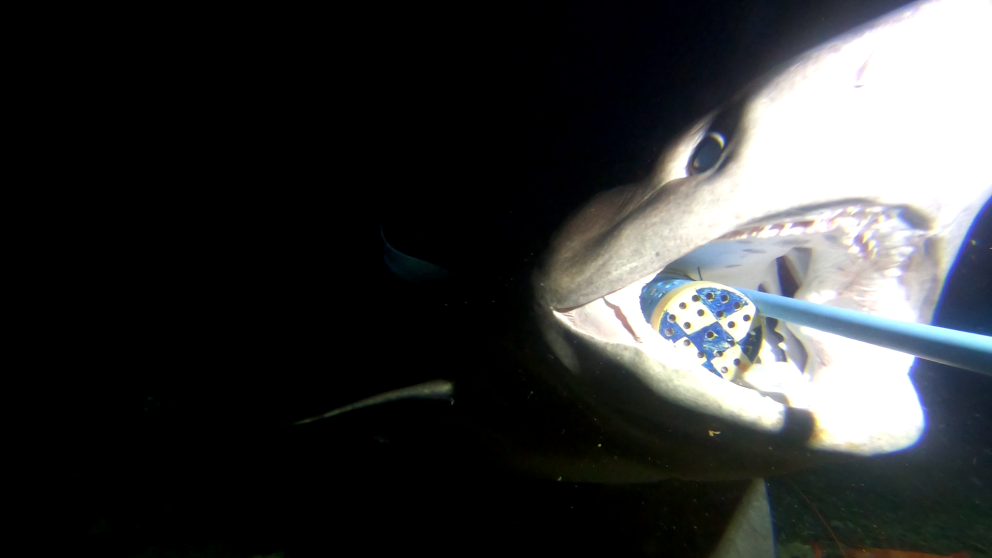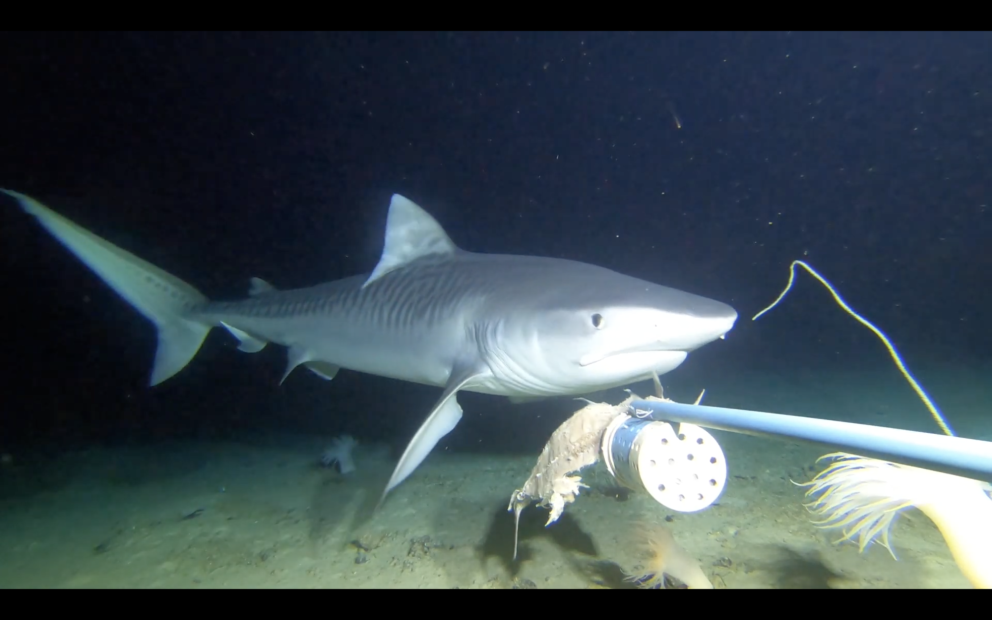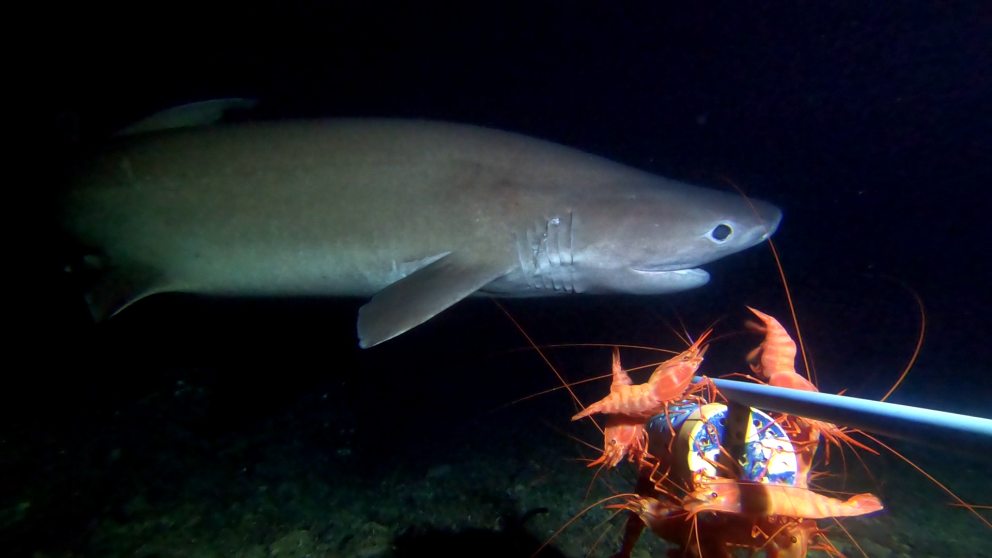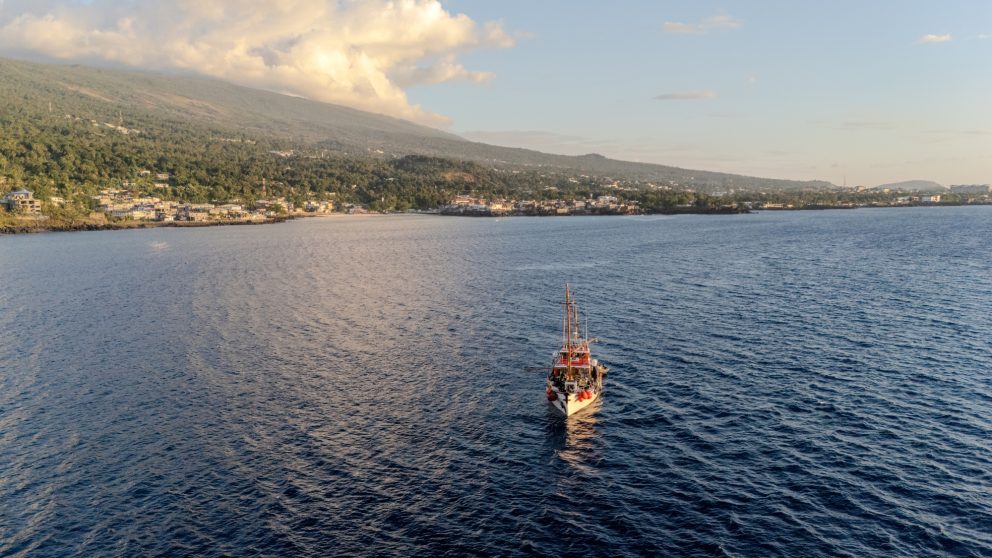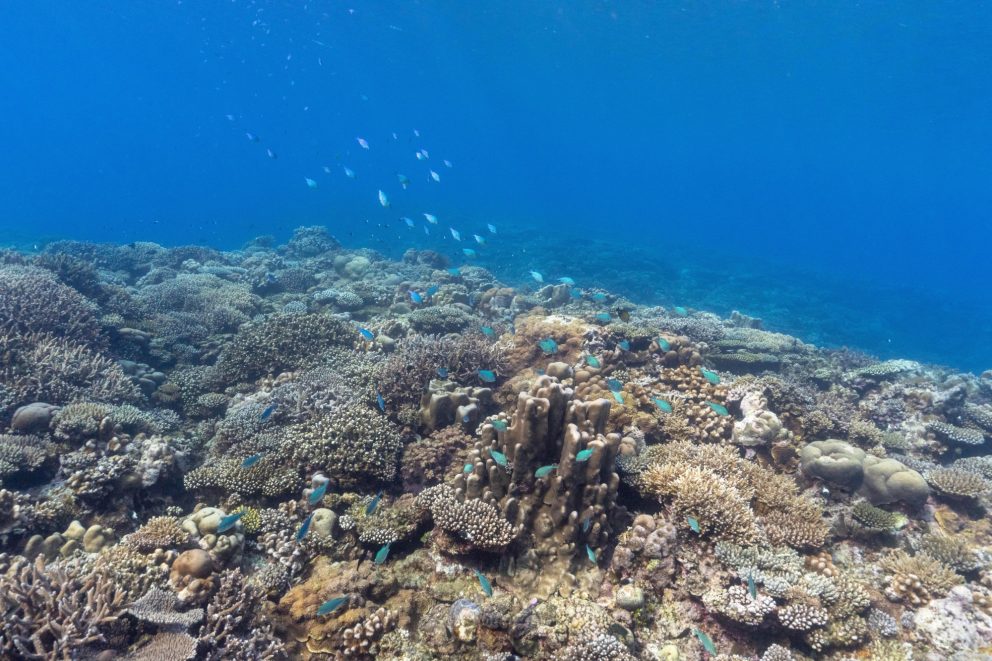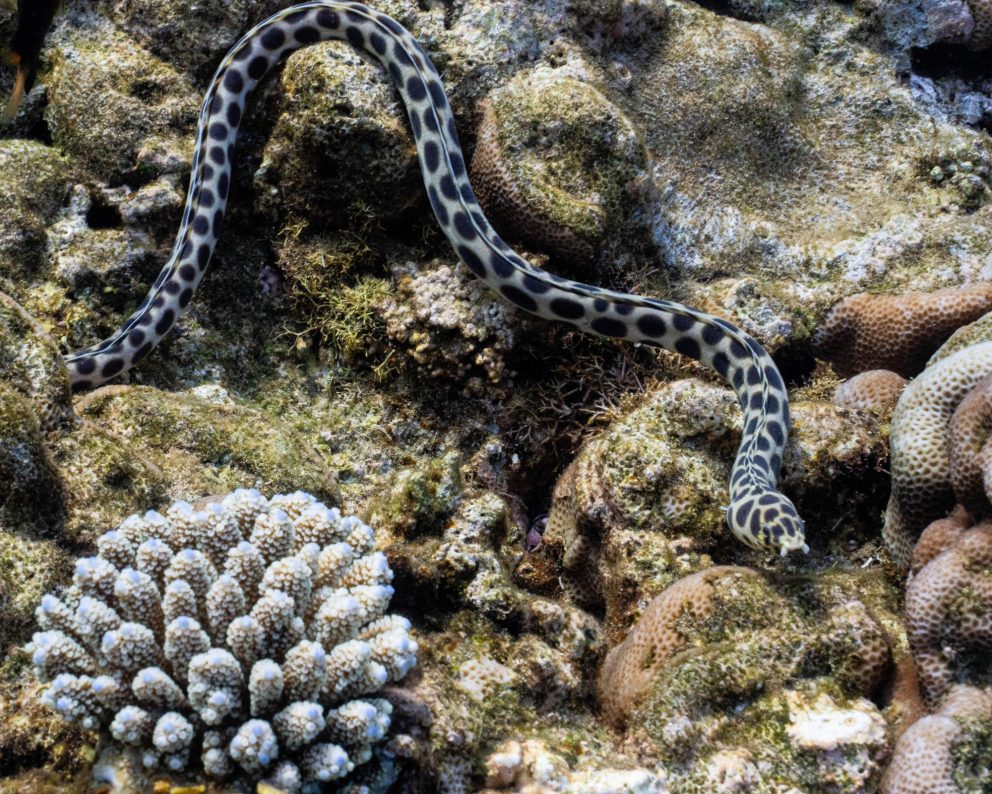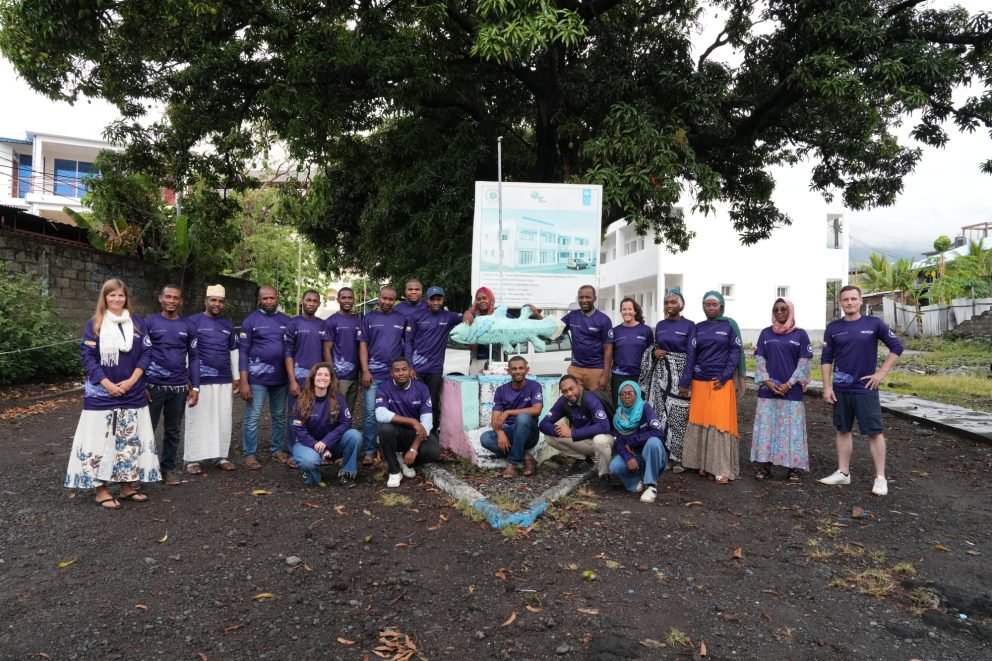
Scientists on the Nekton First Descent: Comoros expedition, 06 October -14 November 2025, have discovered evidence of healthy reefs below 30m and deep-water shark populations off the East African island nation, offering hope that functioning marine ecosystems, vital for mitigating the impacts of climate change on small island states, can still endure if COP30 leaders act now to protect 30% of the world’s ocean by 2030.
Comoros on the Frontline of the Climate Crisis
“Our country is going through enormous difficulties, mainly due to climate change. We observe the rise in sea level every day - it floods our homes, our crops, and our land with salt water. Our coastline and reefs are dying little by little.” H.E. Abubakar Ben Mahmoud: Minister of Environment.
For Comoros, a small island developing state at the heart of the Mozambique Channel – one of the most biodiverse regions on Earth – rising sea levels, ocean heating, and biodiversity loss pose existential threats. Despite contributing little to global emissions, the nation faces the challenge of strengthening national economic and environmental resilience, critically including safeguarding its marine species from extinction - all vital for the future lives and livelihoods of Comorians.
“Climate change is having a huge impact on us,” added Fouad Abdou Rabi, Director of the Comoros Parks Agency. “The Comoros must be stronger in protecting small islands and island states at the highest level of COP, while also showing how we can contribute globally to biodiversity management.”
Oases of Life Beneath the Surface
The First Descent: Comoros team from WILDTRUST, the University of the Comoros, the national R-POC programme and UK-based Nekton witnessed the climate and biodiversity impacts notably from warming seas and overfishing. During the expedition, they recorded alarming signs of marine species loss and habitat degradation in the island’s shallower coastal waters, fuelling fears that some reef-associated shark species may already be functionally extinct around nearshore reefs, as observed elsewhere in East Africa.
“This is very concerning because this is a sign that reef-associated shark species are very low in terms of the size of their population,” explained Joshua Rambahiniarison, CORDIO East Africa shark expert and expedition scientist. “This suggests some depletion, but also the risk of some sharks being functionally extinct.”
Evidence of functioning shark populations — apex predators vital to maintaining ocean balance — was recorded between 300 and 900 metres below the surface, indicating a sustainable food supply and a robust ecosystem at depth. The expedition also brought encouraging discoveries. At depths of 30 metres and below, scientists observed flourishing coral and sponge communities within the mesophotic zone (30–150m), suggesting resilience against human pressures on shallow-water ecosystems.
“The stunning coral communities give a lot of hope,” said Dr. Lucy Woodall, Nekton Principal Scientist and Expedition Co-Chief Scientist. “These corals provide homes for fish that are vital for local communities. There’s now a great opportunity to protect these critical ecosystems and enhance long-term sustainable management.”
A Call for Ocean Leadership at COP30
But scientists warn that local conservation will not be enough. The Comorian and international teams are calling on COP30 leaders in Brazil to uphold their pledge to protect at least 30% of the global ocean by 2030.
“Our planet’s stewards, national political, business and civil society leaders must act now,” said Dr. Woodall. “The ocean is the key to survival, here in Comoros, and for the entire planet. Every country should be thinking about actively protecting 30% of the ocean, because we really are ‘Planet Ocean’."
Notes for Editors
About the Mission
The Government of the Comoros and Nekton, with the Support of Kensington, have partnered with WILDTRUST, under the R-POC programme (Renforcement de la Protection des Océans aux Comores; Strengthening Ocean Protection in Comoros), to complete the nation’s first systematic exploration of its ocean, from the surface to 900 metres. All data collected is owned by and will remain in Comoros and support the country’s goal to protect 30% of its ocean territory by 2030, providing the scientific foundation for new marine protected areas and conservation initiatives.
The mission forms part of Nekton’s ongoing First Descent series, an international initiative exploring and documenting some of the least known regions of the Indian Ocean to advance marine science, regional collaboration, and ocean conservation. By 2050, the Indian Ocean is projected to be home to half of the world’s population.
Mission Newsroom
Video and photographic content, news releases, and background materials will be available through the First Descent: Comoros newsroom, hosted via the Associated Press. https://apmultimedianewsroom.com/nekton
Interviews
Comorian scientists, government representatives, and Nekton’s international team will be available for interviews.
Mission Partners
Nekton
Nekton is an independent, not-for-profit research institute and UK registered charity. Nekton works to accelerate the scientific exploration and conservation of the ocean through expeditions, applied research, storytelling, and knowledge exchange. The Comoros mission is part of Nekton’s First Descent programme, with Past missions in Seychelles and the Maldives forming an ongoing series of Indian Ocean expeditions launched in partnership with regional governments and scientists.
Kensington
Kensington is the leader in private guided luxury travel, offering bespoke journeys in over 120 countries. Its portfolio spans Kensington Tours, Cruises, Villas, Air, and sister company Kensington Yachts, a dedicated yacht brokerage that blends land and sea experiences. Its newest addition, Kensington Expeditions, takes luxury and adventure to new heights with immersive itineraries across land, sea, air, and even space.
CORDIO East Africa
Coastal Oceans Research and Development in the Indian Ocean (CORDIO) East Africa is a non-governmental organisation working at the intersection of marine science, conservation policy, and community practice across the western Indian Ocean. Its work supports sustainable resource use, fisheries management, and improved governance of marine ecosystems.
WILDTRUST (WILDOCEANS programme)
WILDTRUST is a South African-based non-profit organisation working through its WILDLANDS and WILDOCEANS programmes to advance “A Thriving and Resilient World.” The WILDOCEANS programme champions inclusive, locally rooted solutions that conserve and restore marine ecosystems while building sustainable livelihoods for coastal communities and driving national and regional action toward the global 30x30 conservation target.
NRF-South African Institute for Aquatic Biodiversity
NRF-SAIAB, a national facility of South Africa’s National Research Foundation, operates advanced research platforms for aquatic biodiversity science across diverse environments. Through research, training, and innovation, NRF-SAIAB contributes to the nation’s Blue Economy and supports the education and development of future aquatic researchers and managers.
1. Bluntnose Sixgill Shark (Hexanchus griseus), 740m m
Filmed using Baited Underwater Video Systems (BUVS) at a depth of 600 metres near Raya Bank. These deep-sea sharks can exceed 5 metres in length; this individual was recorded actively feeding on the bait.
2. Tiger Shark (Galeocerdo cuvier), 300 m
Captured on BUVS at 300 metres near Raya Bank. This juvenile tiger shark, approximately 1.8 metres (6 feet) long, was observed repeatedly feeding on the bait.
3. Bluntnose Sixgill Shark (Hexanchus griseus), 740 m
Recorded on BUVS at 600 metres near Raya Bank. One of the ocean’s largest predatory sharks, H. griseus can reach lengths of up to 5.5 metres. This specimen circled and fed vigorously at the bait site.
4. R/V Angra Pequena, Grande Comore
The 22-metre research vessel Angra Pequena underway off Grand Comore during the First Descent: Comoros expedition.
5. R/V Angra Pequena, Moroni, Comoros
The research vessel Angra Pequenas working close to Moroni, capital of Comoros, during preparations for the deep-sea mission.
6. R/V Angra Pequena, Grande Comore
The Angra Pequena operating off Grand Comore, supporting BUVS deployments and deep-water survey work.
7. Coral Reefs, Grande Comore
Vibrant shallow-water reefs fringing Grande Comore. While many corals remain healthy, these ecosystems face rising pressure from human impacts and coastal development.
08. Spotted Snake Eel (Myrichthys maculosus), Anjouan
Observed off the island of Anjouan. Though resembling a sea snake, this species is a burrowing eel adapted for camouflage in sandy and coral habitats.
09. Expedition Team, University of Comoros
The full Nekton and Comorian science team gathered at the University of Comoros Marine Laboratory ahead of the mission launch, standing beside a statue of the nation’s iconic coelacanth.
10. Deck Team Deploying BUVS Landers, R/V Angra Pequena
The deck crew deployed one of several BUVS landers. These systems collect critical high-definition video from the seabed and require coordinated teamwork for safe launch and recovery.
SHOT LIST
RESTRICTIONS - Access all territories, all platforms, in perpetuity. No commercial archive resale
(All shot Oct 5-Nov 5 2025)
Grande Comore
1. Tiger shark trying to eat from subsea bait camera systems placed by Nekton First Descent:Comoros scientists between 300m and 850m off coast
2. Bluntnose six gill shark showing interest in bait
3. Tiger shark close up
4. Bluntnose six gill shark eating bait
5. False cat shark scanning sea floor for food
Raya Bank,Comoros
6. Nekton First Descent:Comoros science team launch bait cameras from research vessel
7. Research vessel Angra Pequena at sea
8. Waterline shot of research vessel
Moroni,Grande Comore
9. SOUNDBITE (FRENCH) DR.NADJIM AMHMED MOHAMED, EXPEDITION CO-LEADER
“This expedition is crucial for the 30x30 objective because it allows us to explore areas we don't yet know. And based on the findings of this expedition, we can establish protected zones. This means that, globally, we will be able to meet the goal of reaching 30% by 2030.”
Mitsamiouli National Park
10. Aerial of harbour defences
Southern Grande Comore
11. Salt water inundation of mangroves
12. Salt water flowing on shore
Moroni,Grande Comore
13. SOUNDBITE (COMORIAN) ABUBAKAR BEN MAHMOUD, ENVIRONMENT MINISTER
“Our country is going through enormous difficulties, mainly due to climate change. For example, we observe the rise in sea level every day. It even penetrates our homes, our crops, flooding our land with salt water.Today our coastline, our coastal reefs are dying little by little.“
Mutsamudu, Anjouan
14. Aerial of damaged coast susceptible to storm surges
15. Plastics pollution ,discarded fishing gear washed up on shore
National Park, Grande Comore
16. SOUNDBITE (FRENCH) FOUAD ABDOU RABI , NATIONAL PARKS AGENCY DIRECTOR
“Climate change is having a huge impact on us. The Comoros must be stronger in protecting small island and island state at the highest level of COP while also showing how we can contribute globally to biodiversity management.”
Moroni, Grande Comoroe
17.Aerial Comoros people swimming and enjoying sandy beach
18. Tuna fish being shopped in market
19. Market scenes with shoppers
20. SOUNDBITE (FRENCH) HOUSSOYNI HOUSSENI, OCEAN CONSERVATIONIST
“Marine protected areas can really help with the implementation of protection measures because they already exist. They can help better protect ecosystems so that we can truly achieve food security and also protect resources, whether fisheries or other ecosystems that are crucial for the Comorian people and for the world.”
Mitsamiouli, Grande Comore
21.Pupils learning ocean literacy in classroom
Anjouan
22. Aerial of locals fishing with net from canoe
23. Aerial shallow reefs
Moroni, Grande Comoroe
24. SOUNDBITE (ENGLISH) JOSHUA RAMBAHINIARISON, SHARK RESEARCHER
“This is very concerning because this is a sign that reef associated shark species are very low in terms of the size of their population; so quite suggests some depletion but also the risk of being functionally extinct.”
Grande Comore
25. Underwater coral reef shots
Anjoun
26. Snake eel swimming on bottom of sea
Grande Comore
27. Various small fish amidst coral reefs
Off Moroni
28. SOUNDBITE (ENGLISH) DR. LUCY WOODALL, NEKTON EXPEDITION CO-LEADER
“The coral communities here in Comoros, some of them are stunning, they are really beautiful and this gives a lot of hope. This means that the coral can provide homes for the fish which are really important for the communities here. So now there's a great opportunity, an opportunity for protection, for long-term sustainable management.”
Raya Bank
29.Aerial of research vessel with umbilical line to ROV - Remotely Operated Vehicle
Off Moroni
30. ROV operating underwater taking video
31. Science team making measurements of samples
32. Coral specimen in tray
33. Scientist photographs sample
34. SOUNDBITE (ENGLISH) DR. LUCY WOODALL, NEKTON EXPEDITION CO-LEADER
“That world leadership in making a commitment, understanding that the ocean is the future for survival both here in Comoros but in indeed for the whole planet and I think that really shows leadership and where every other country should be going, really thinking about protecting and highly protecting 30% of the ocean sustainably managing the rest of it because we do need this ocean because really we are 'planet ocean’.“
Anjoun
35. Aerial of waves hitting beach, tilts to coastline shot
Raya Bank
36. Aerial pygmy killer whales
37.Underewater pgymy killer whales
Off Moroni
38. Aerial of research vessel off coast
--------------------------------------------------------------------
CR ON-SCREEN CAPTIONS
Sharks, the ocean’s apex predators, observed by the Nekton First Descent:Comoros expedition off the East African coast
Their presence at depths of 300m-900m suggests a sustainable food supply, indicating a healthy marine ecosystem
But the absence of shark species in the shallows has sparked grave concern about habitat degradation and species loss
SOUNDBITE (ENGLISH) JOSHUA RAMBAHINIARISON, SHARK RESEARCHER
“This is a sign that reef associated shark species are very low . This suggests the risk of being functionally extinct.”
Comoros government ministers say rising sea levels, sparked by the climate crisis, are of major concern
A healthy ocean is vital for the Comoros in mitigating the impacts of climate destabilisation
SOUNDBITE (COMORIAN) ABUBAKAR BEN MAHMOUD, ENVIRONMENT MINISTER
“Our country is going through enormous difficulties, mainly due to climate change. For example, we observe the rise in sea level every day. It even penetrates our homes, our crops, our land, flooding with salt water."
Comoros is emblematic of many frontline climate crisis states - it is not one of the world’s major polluters.
Yet faces the challenge of funding and fixing the damage to save species from extinction and feed its population
SOUNDBITE (FRENCH) FOUAD ABDOU RABI , NATIONAL PARKS AGENCY
“Climate change is having a huge impact on us. The Comoros must be stronger in protecting small island and island states at the highest level of COP"
Comorian and Nekton scientists are calling on COP to show global leadership and live up to a commitment to protect 30% of the ocean by 2030
SOUNDBITE (ENGLISH) DR. LUCY WOODALL, NEKTON EXPEDITION CO-LEADER
“World leadership in making a commitment, understanding that the ocean is the future for survival both here in Comoros but in indeed for the whole planet … because really we are 'planet ocean'. “
Ends on Music

